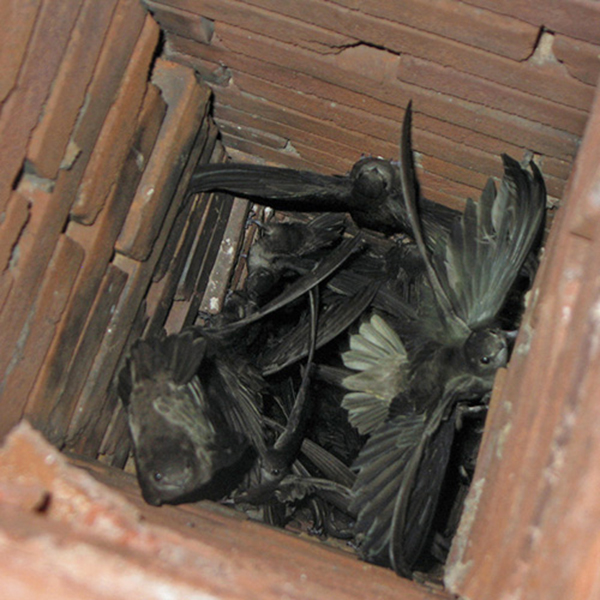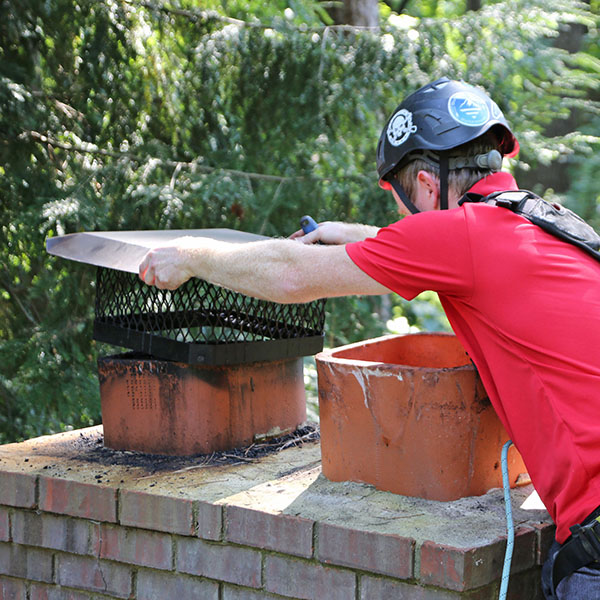Keep Animals Out
With its proximity to the beautiful shores of Lake Michigan, the Burlington-Racine-Kenosha, WI, area is nature’s paradise. It’s also a lovely area for wildlife like bats, Chimney Swifts, raccoons, squirrels, and even vultures. These wild animals always hunt for shelter to rest, stay warm and dry, and hide from predators. So, it’s not uncommon to find a family nesting in a chimney.
 How Animals Get in Your Chimney
How Animals Get in Your Chimney
So, you may be wondering how these critters get in your chimney in the first place. Well, it’s easier than you may realize:
- With their sharp claws and teeth, you will be surprised how quickly a squirrel can climb up a masonry chimney when chased by a neighborhood predator.
- Small birds, bats, and vultures flying around at night often land on the roof and chimney top. An open flue is a warm and cozy place to spend the night and raise their young.
- However, small animals don’t have to travel to the top of the stack to gain entry. Some can easily squeeze through gaps in the masonry caused by mortar decay or damaged brickwork. Once inside, they can slide or fly down the flue and into your home if your damper is open.
- Tree branches that hang over your roof make your chimney more vulnerable to small animals and birds. Trim tree branches away from your roof and chimney.
Cracked Crown
If you’re scratching your head wondering how that rat, skunk, or another critter got trapped inside a capped chimney, they may have squeezed through a crack in the crown. The cement surface that tops a masonry chimney is another common entry point when cracking from normal wear and tear, house settling, or storm damage. A lightning strike can also take a chunk out of the crown. And, yes, lightning can and does strike the same place twice.
Gaps in the Masonry
The continuous freezing and thawing of rain-soaked brick and mortar eventually melt away the porous mortar leaving gaps in the joints that can result in cracked, flaked, and crumbling bricks. When you look closer, your bricks may have tiny holes like a sponge or big holes like Swiss cheese. Insects, pests, rodents, and other wildlife enter the chimney through these gaps. They quickly multiply, and before you know it, there is an infestation in your chimney and home.
Worn Damper Gasket
It would be best to close the damper after the fire burns out in the fireplace. However, when the rubber damper gasket is worn, it will not create an air-tight seal. So not only will it increase your energy costs, but it won’t keep animals out, either. That’s why Burlington Fireplace recommends annual chimney inspections so worn components can be repaired or replaced before moisture, humidity, and small animals invade and damage your chimney, flue, fireplace, or other attached heating appliance.
 Broken Chimney Cap
Broken Chimney Cap
An exposed flue pipe is a favorite entry point for small birds that migrate through southern Wisconsin and Northern Illinois as they cross Lake Michigan. Burlington Fireplace recommends homeowners repair or replace a damaged chimney cap or chase cover as soon as possible. It should also have a substantial mesh screen to keep animals out of the flue.
Keeping Animals Out of Your Chimney
Does your chimney cap, chase cover, or flue cap need repair or replacement? Call Burlington Fireplace at 262-763-3522 to schedule a chimney inspection and keep wild animals out of your chimney, flue, and fireplace. We serve customers throughout southern Wisconsin and northern Illinois, including Lake Geneva, WI, Kenosha, WI, Fox Lake, IL, and Waukegan, IL. You can also contact us online here.
